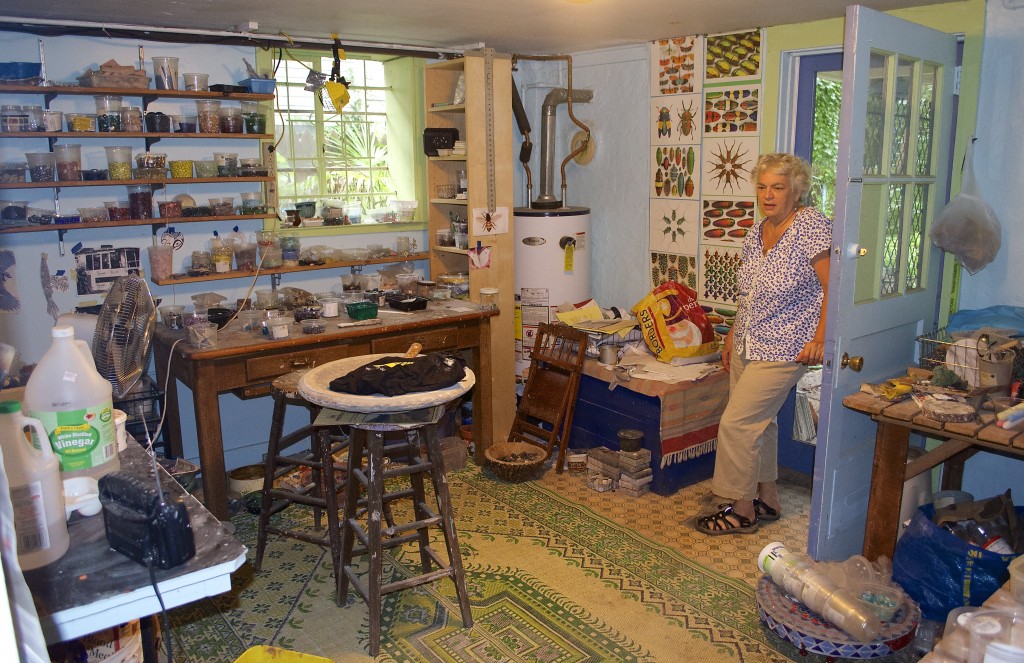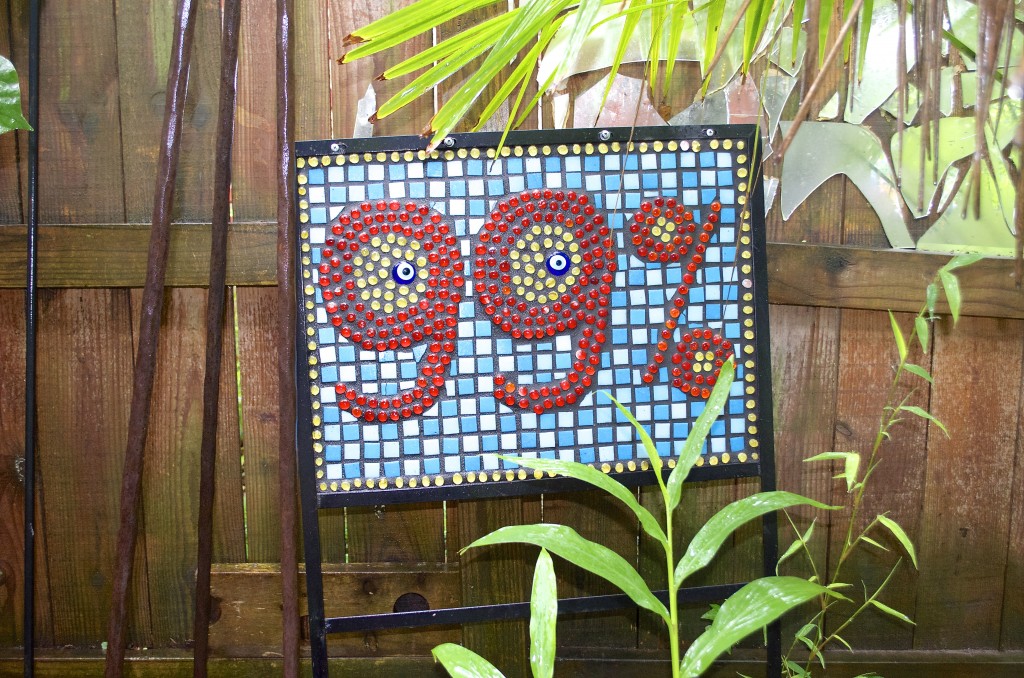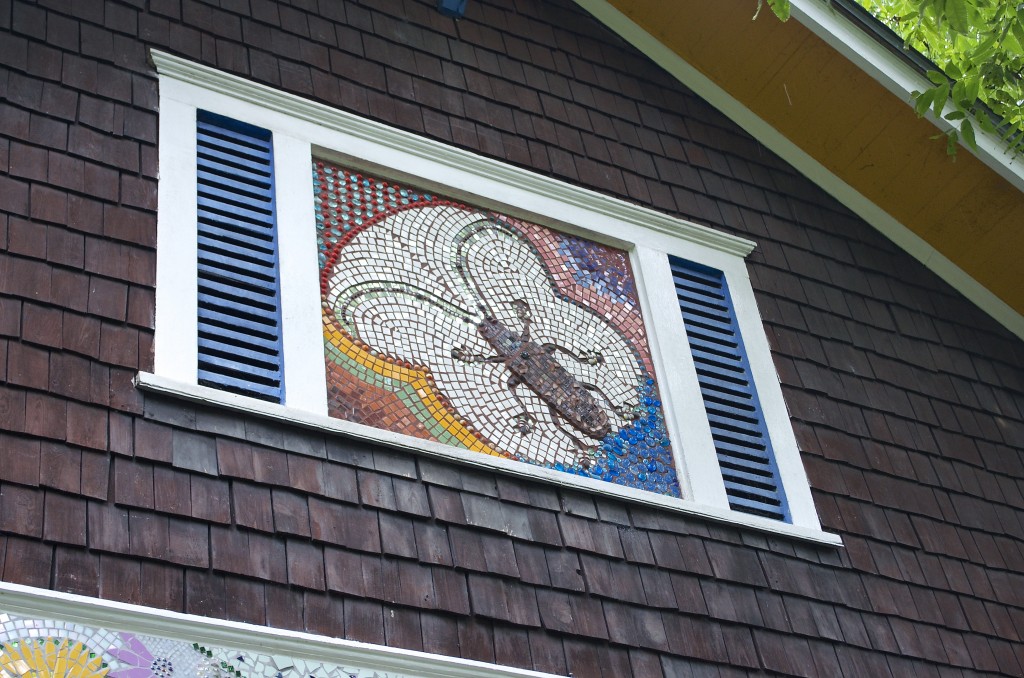A Conversation with Stephanie Coffin

Stephanie Coffin stands in front of her Highland View home, where she’s used mosaics extensively to decorate the exterior. The mural that runs the width of her home above the porch depicts the environmental impact of the Deepwater Horizon oil spill which devastated the Gulf of Mexico near New Orleans in 2010. To view close-ups of the mural, click on the photo album link below.
By: John Becker
Stephanie Coffin and her husband Tom have lived in Virginia-Highland for forty years, moving from Midtown to their current home on Highland View in 1973 when Stephanie was “very pregnant” with their second child.
Many VaHi residents know of the Coffins’ involvement with The Great Speckled Bird, the iconic counterculture weekly that grew out of an anti-Vietnam War newsletter published by the pair and others during Tom’s time at Emory in the late 60’s. The Bird, as it was known, never missed an issue during its eight-year run (1968 – 1976) and it became known as one of the nation’s premier underground newspapers with an impressive circulation of 22,000 at its peak. For more on The Bird’s fascinating story, check out this link and this link.
Stephanie Coffin remembers her years of activism fondly, but today she spends much of her time trying to make a difference in the neighborhood where she’s lived for so long. She’s a past chair of the VHCA’s parks committee, a passionate arborist and a talented artist. You can see her colorful mosaics at Sevenanda in Little Five Points, at the Truly Living Well urban garden in Old Fourth Ward (this piece was originally part of 2012’s Art on the BeltLine program), and throughout the neighborhood. Her home – inside and out – is homage to what can be done with a few pieces of colorful glass, a little adhesive and some grout.
Coffin’s most recent work – a colorful mosaic on the east-facing wall of the Intown Ace Hardware planter at the corner of N. Highland Avenue and Drewry Street – caught our eye last week and we thought we’d reach out to the artist to get the scoop on how it came about.
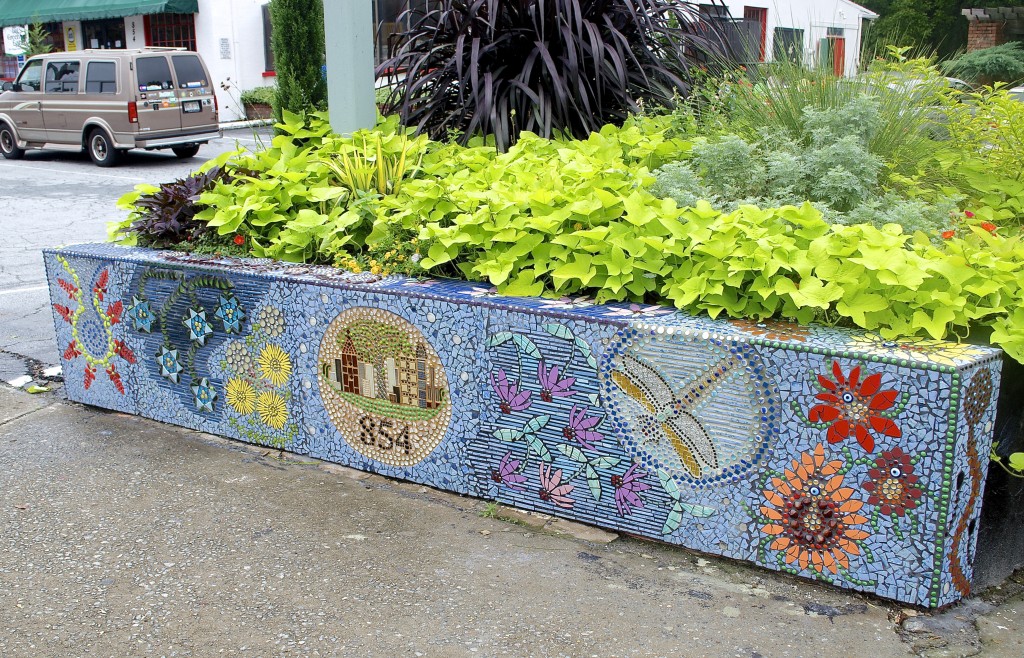
Coffin’s newest mosaic – Atlanta Afloat – adorns the wall of the Intown Ace Hardware planter that faces N. Highland Ave.
Before we talk about mosaics, I know you and your husband were part of the group that founded The Great Speckled Bird. That must have been an interesting and rewarding time for you two.
It was absolutely the most exciting time of our lives. It was incredible. The whole country was being turned upside down by issues like the war and the civil rights movement. It was sort of the tail end of the civil right movement, but it was still very much a struggle at the time. We were right in the middle of it – the good and the bad – and I’ll always recall how passionately we spoke up for what we believed in.
You’re a passionate arborist, too, right? Tell me a little about that.
In the early ‘90’s I became interested in protecting and preserving trees and today both my husband and I are active members of the Georgia Arborist’s Association. I also work closely with Trees Atlanta and have personally coordinated numerous Trees Atlanta plantings throughout Virginia-Highland. Over the years I’ve probably planted or helped plant hundreds of trees in the neighborhood.
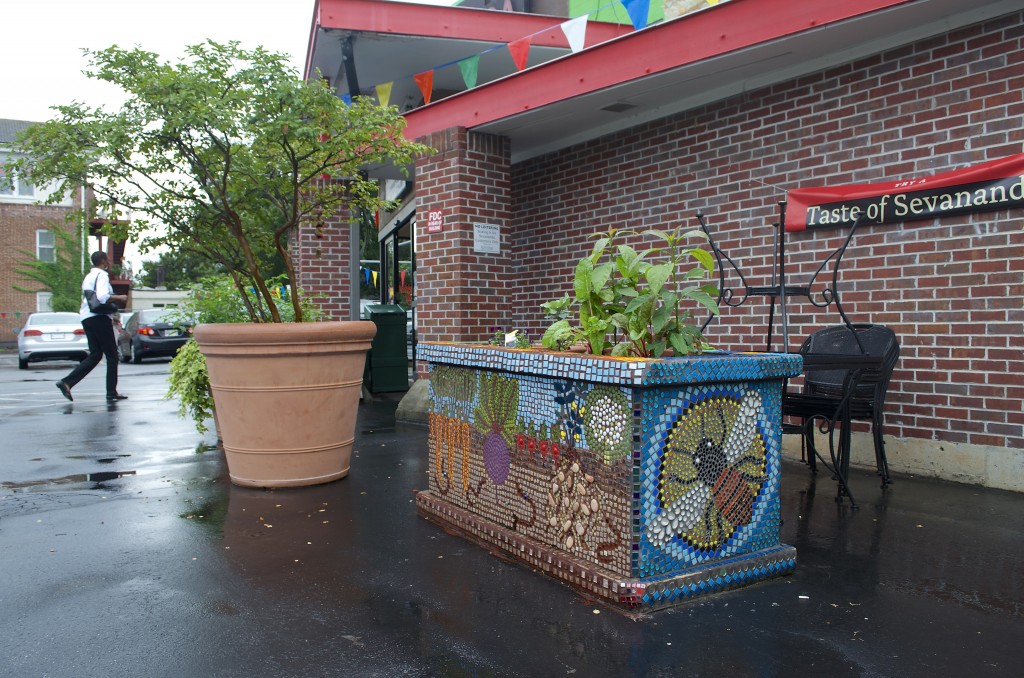
Coffin created a 4-sided mosaic for this planter outside the front door at Sevananda in L5P. View our photo album (link below) for photos of the other three sides.
When and how did you start doing mosaics?
It was about 15 years ago. I needed to make some improvements in the kitchen – including a new backsplash – and I was very interested in colors and shapes and I found the mosaics to be a fun and artistic of way of doing the improvements. I liked the kitchen improvements so much I just kept going. I did the front walk, then the upstairs, then the back of the house. All of my initial work was here at the house. Once I got my feet on the ground I started doing work for others.
How did you learn about the process of creating mosaics?
I’m self-taught. The library has many good books on how to create mosaics and I just read as many as I could find and just started doing it. It’s not difficult to get going. Anyone who wants to learn should read up on the subject, then just pick a small project to start with – a birdbath or small clay pot to decorate, for example – and before you know it, you’ll be hooked.
Can you tell me a little about how they’re made?
The process of creating a mosaic varies depending on what it is you’re creating. But the basic process starts with designing the image you want to create and determining what pieces you’ll use to create it (this is usually the most time-consuming part of the process), then using adhesive to affix the pieces to the surface you’re covering, and finally using grout to fill in the spaces between the pieces to create the final image.
When/how did you come up with the idea to do a mosaic on the planter at Ace Hardware?
Intown Ace is such a great part of the business community here and a real asset to the neighborhood. I’d had my eye on their planter for some time. People walk or drive by it all the time and I knew I could improve its drab appearance. At the same time, one of the biggest problems for artists today is to find places to display their art. It’s a huge problem and it has forced artists to become creative in finding places to show what they create. The Ace Hardware planter is a perfect example of what you can come up with if you’re creative. It was a way for me to share my art with the community and make the neighborhood more beautiful at the same time.”
How long did it take to create the mosaic? Is there a title?
The most time-consuming part of creating a mosaic is the upfront time you put in figuring out what you want to do and how you’re going to do it. I started designing the Ace Hardware mosaic in January, slowly started building the mosaic in March and had the main work complete by late July. I’ve gone once or twice during August to put on some finishing touches. And yes, the mosaic has a title. I call it Atlanta Afloat. You can see the image of the city’s skyline in a ‘bubble’ in the center surrounded by various types of ocean life.
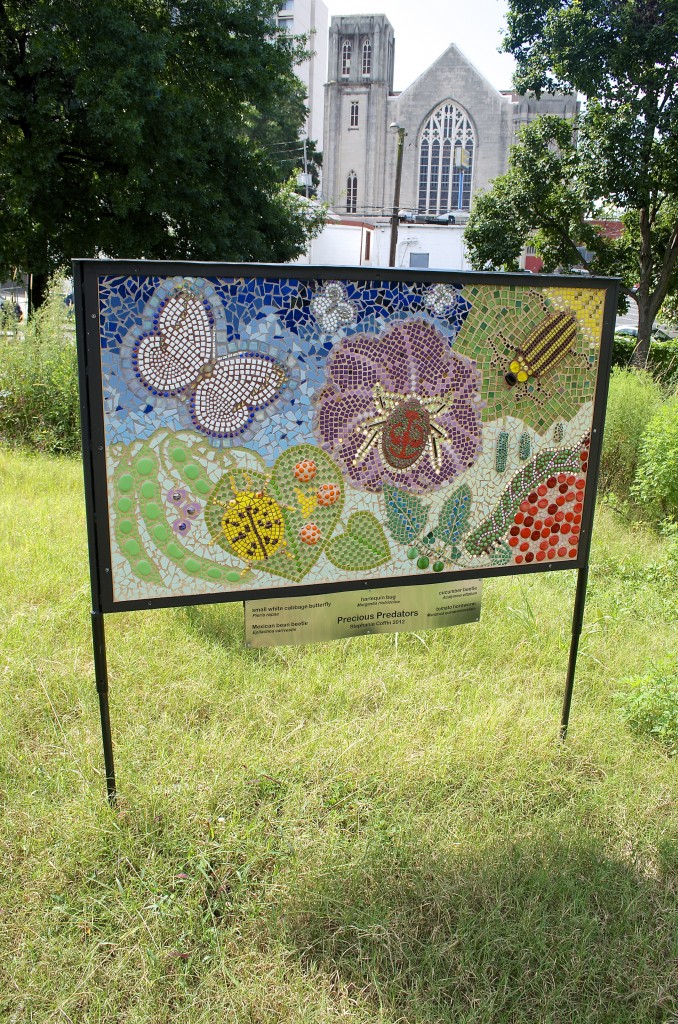
Coffin created this mosaic for the 2012 Art on the BeltLine exhibit. It now stands at the Truly Living Well community gardens in Old Fourth Ward.
What sort of reaction have you received?
I spent a good deal of time at the planter doing the installation and plenty of folks stopped to say how beautiful it looked and how nicely it was coming along. I’ve gotten lots of very positive feedback since it’s been finished. It’s been very gratifying.
Have you talked with the folks at Ace Hardware about doing the rest of the planter?
They’ve talked about it and I certainly have ideas – I’d love to do something to acknowledge the chickens in their coop, for example – but we haven’t gotten serious about it yet so nothing’s actually in the works.
What about other examples of your mosaic work? Where can they be found?
Two years ago I put mosaics on two different planters in front of Sevenanda on Moreland Ave. in Little Five Points – one four sided, the other two sided because of its close proximity to a fence. Everyone was very pleased with the way they came out and I came away from the experience with a great understanding of how to create mosaics for planters.
Last year I created a mosaic mural that was on temporary display during Art on the BeltLine. It’s a 5′x3′ mosaic mural of glass, marble and ceramic tile mounted in a steel frame that was anchored in concrete. The mural shows enlarged images of the five most damaging insects for organic gardeners, and the plants they attack. Unfortunately they put the mural way down on the southwest side of the BeltLine where nobody was really going. The area wasn’t even handicap accessible so it makes you wonder why they’re putting art in places where people aren’t even supposed to be going. After the exhibit ended I rebuilt the piece and installed it at the Truly Living Well community gardens on Hilliard St. in Old Fourth Ward where it stands today. I’m especially fond of this piece because it’s both artistic and educational.
What’s next?
I have a neighbor down the street I’m going to do a street number plate for, and I have a few others I’ve spoken with about that kind of work (which I’ve already done some of in the past). Nothing major, though. I’m keeping my plate fairly clean in case the Ace Hardware folks decide to move forward with the rest of the planter.
————————————————————————————————
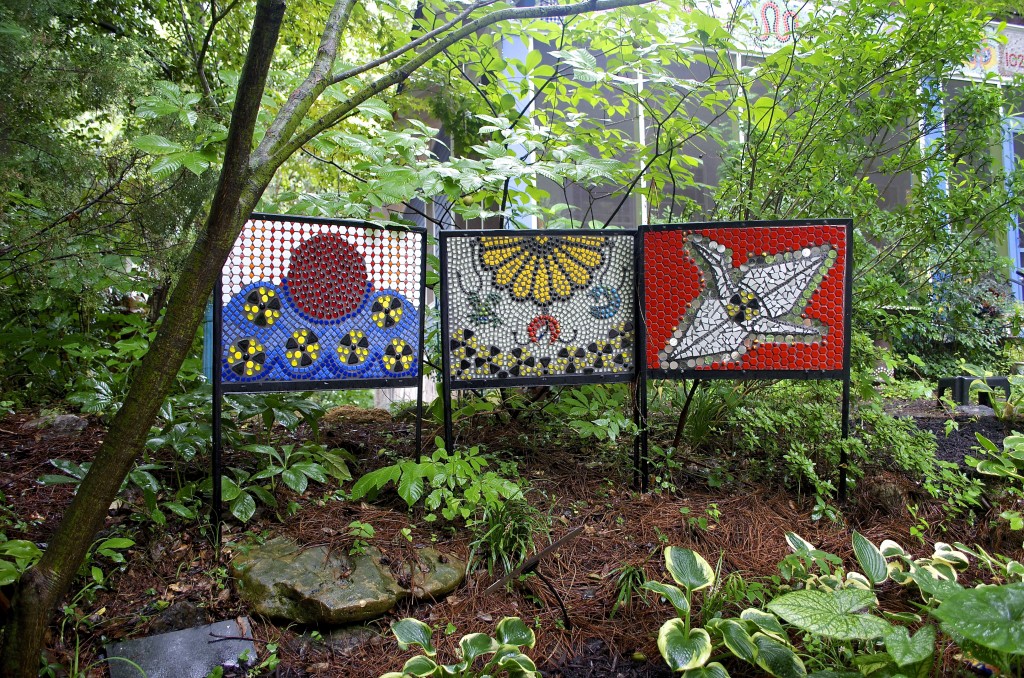
Coffin created this three panel mosaic to illustrate the impact of the 2011 Fukushima Daiichi nuclear power disaster.
Editor’s Note: Intown Ace Hardware garden center manager Robbie Cotney says they’re seriously thinking about asking Stephanie to do the other three sides of the planter.
“We’re very pleased with the many positive comments we’ve gotten about Stephanie’s mural,” he said, “and we’re seriously considering asking her to come back and decorate the planter’s remaining three sides. If we decide to go forward with the work, we’ll definitely be compensating Stephanie for her time and work.”
Coffin did the work on the planter’s east-facing wall for free, with Ace Hardware picking up the cost of most of the materials.
The Voice would also like to suggest that the Tour of Homes committee consider including at least an exterior tour of Coffin’s home on a future tour. We think folks would love to see how Coffin has used mosaics to decorate her home and get ideas aplenty about how they might do the same themselves.
Click here to view an album of photos of Stephanie Coffin and her work. Click here to view a YouTube video of the mosaics Stephanie’s created around her home.
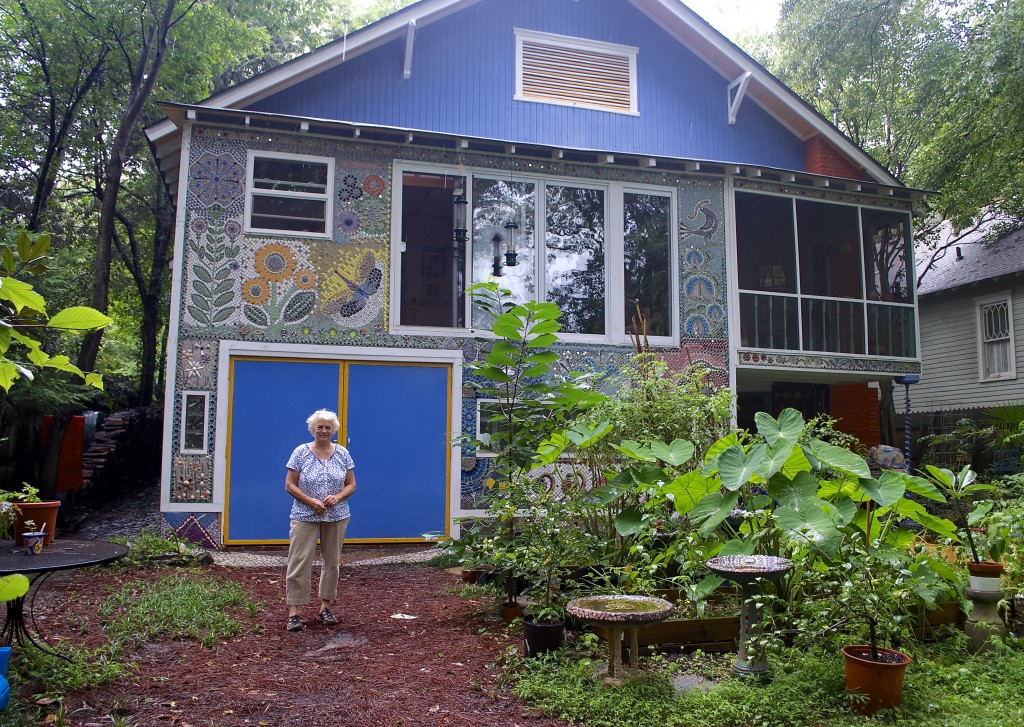
Coffin has covered much of the back of her home with mosaics, and there are enough birdbaths scattered around to satisfy even the thirstiest flock of birds.
